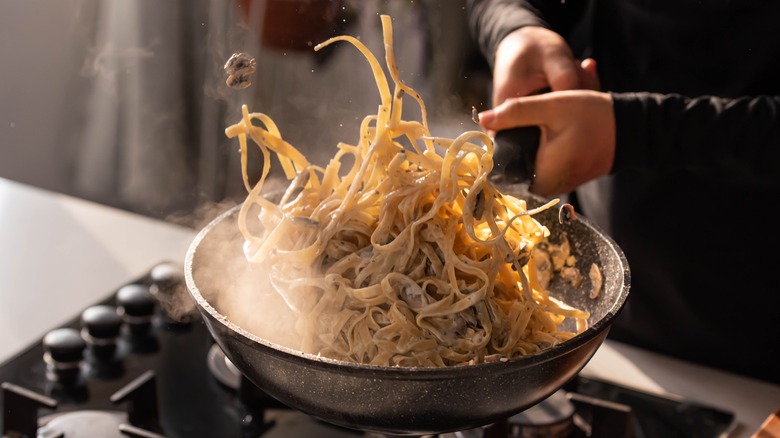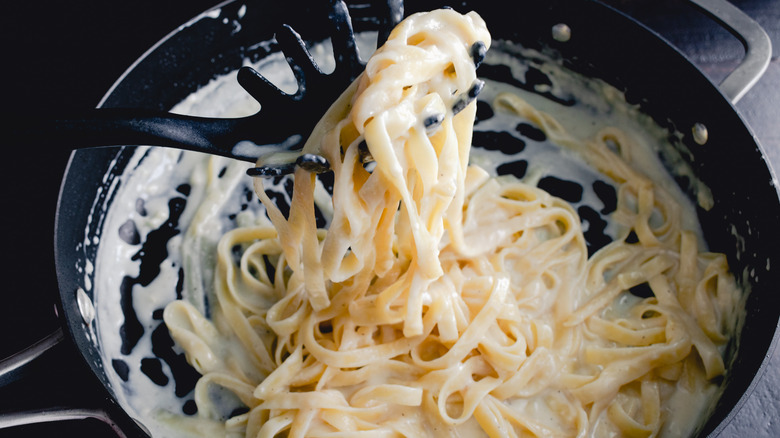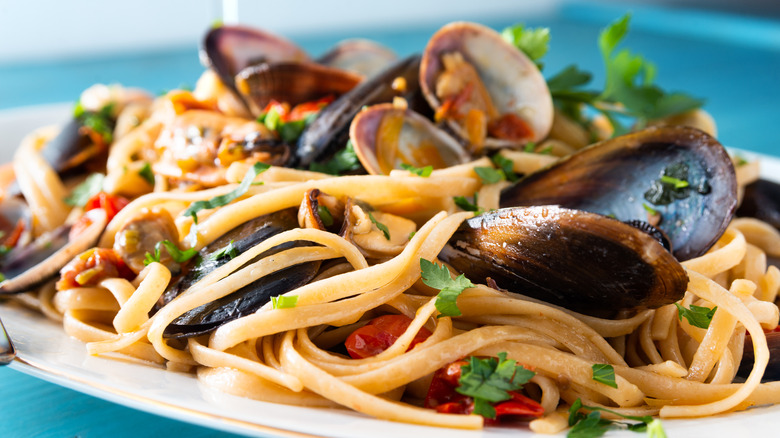Linguine Vs. Fettuccine: Which Is Best For Creamy Sauces
There are roughly 350 types of pasta in existence. Granted, many of these are identical to another; they just have different regional names. If you take that factor out, there are around 50 distinct types of pasta. Of these 50, there are shapes that can be mistaken for others, including fettuccine and linguine. Although similar, the two are made completely differently and are traditionally meant to be eaten with different sauces.
Fettuccine is a wide, flat, long pasta that originated in the Rome and Tuscany areas of Italy. It's made with eggs and flour, making it heartier than pastas made with flour and water. Its name means "little ribbons,32.0" which perfectly describes the look and feel of fettuccine. Because of its substantial surface area, fettuccine is best with creamy or heavier, chunky sauces. The large strands cling to all of that goodness like no other pasta.
If you took a strand of spaghetti and flattened it just a little bit, you'd get something that resembles linguine. This pasta from Genoa is somewhat flat but still has rounded ends, and it's not as wide as fettuccine. It's also lighter than fettuccine because it's made with flour and water, with no eggs. Linguine doesn't cling to hearty sauces the way fettuccine does. It's better suited for lighter, olive oil-based sauces. You also might find yourself reaching for these two pastas at completely different times of the year.
The time and place for fettuccine
A warm bowl of pasta is what many people crave on cold nights when they want to curl up under a blanket and binge Netflix. Due to its filling nature and affinity for velvety sauces, fettuccine is perfect for those occasions when it's comfort you want in the dead of winter. Alfredo sauce is fettuccine's best friend, but a slow-cooked Bolognese is also a winner.
Anything rich will work beautifully with fettuccine. Think tomato cream sauce, pumpkin cream sauce with toasted hazelnuts, or creamy pesto. Even an Asian-inspired sesame or peanut noodle recipe, complete with vegetables and chicken or shrimp, would be delightful.
Take inspiration from the cold seasons as well, using bitter greens, squash, mushrooms, and sausage in your creations. The cold season is also a great time to pick up the hobby of homemade pasta — fettuccine is a simple one to achieve.
When linguine is best
When you crave pasta in the summertime, it's most likely not a steaming bowl of Sunday gravy-covered noodles you're after. Instead, you'll want something that you can eat outside under the sun with a cool glass of Pinot Grigio. Linguine is perfect for such occasions.
One of the most beloved dishes made with linguine is linguine with clam sauce. Its light consistency pairs deliciously with the olive oil, lemon, parsley and clams. Linguine is great tossed with fresh tomatoes and herbs; shrimp scampi; a simple sauce of olive oil, garlic, and chili flakes; tuna and sun-dried tomatoes; crab meat; or anything bright and summery.
If you find yourself at home on a cold day with a hankering for pasta and meat sauce and all you have is a box of linguine in your pantry, go ahead and use it. You might not be able to hold onto as much sauce as you'd like — but that's why we have slices of bread on the side to scoop up the rest.



